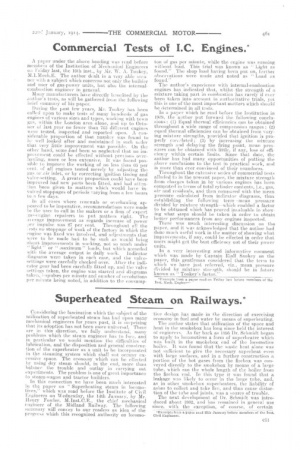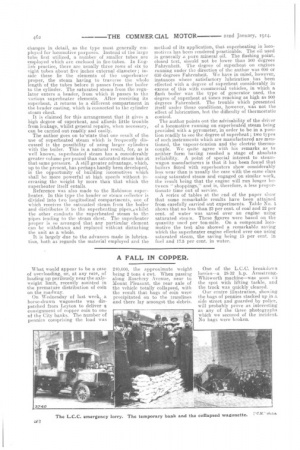Superheated Steam on Railways.*
Page 15

Page 16

If you've noticed an error in this article please click here to report it so we can fix it.
Considering the fascination which the subject of the utilization of superheated steam has had 'upon many mechanical engineers for years past, it is surprising that its adoption has not been more universal. There tic in this direction, we fully understand, many problems which the steam engineer has to face, and in particular we would mention the difficulties of lubrication, and the disposition and general construction of the superheater as a unit -to be incorporated in the steaming system which shall not occupy excessive space. The economy which can be effected by using dry steani should, in the end, more than balance the trouble and outlay in carrying out experiments. The problem is one of great importance to steam-wagon and tractor builders. In this connection we have been nmeh interested. in the paper on " Superheating steam in locomotives," which was read before the Institute of Civil Engineers on Wednesday, the 14th January, by Mr. Henry Fowler, M.Inst.C.R. the chief mechanical engineer of tire Midland Railway. The following summary will convey to our readers an idea of the progress which this recognized authority On locomo
tive design has made in the direction of exercising economy in fuel and water by means of superheating.
The author states that utilization of the space and heat in the smokebox has long since held the interest of engineers. As far bank as 1895 Dr. Schmidt began to apply to locomotives a form of superheater which was built in the smokebox end of the locomotive boiler. It was found that the waste heat alone Was not sufficient to give the necessary superheat even with large surfaces, and in a further construction a portion of the hot gases from the firebox was conveyed directly to the smokebox by means of a large tube, which ran the whole length of the boiler from the firebox end. In this type it was found that a leakage was likely to occur in the large tube, and, as in other smokebox superheaters, the liability of ashes to collect and take fire, and thus cause distortion of the tube and joints, was a source of trouble.
The next development of Dr. Schmidt was introduced about 1902, and has remained it) general use since, with the exception, of course, of certain changes in detail, as the type most generally employed for locomotive purposes. Instead of the large tube first utilized, a number of smaller tubes are employed which are enclosed in fire-tubes. In English practice, there are usually three rows of six to eight tubes about five inches external diameter ; inside these lie the elements of the superheater proper, the steam having to traverse the whole length of the tubes before it passes from the boiler to the cylinder. The saturated steam from the regulator enters a header, from which it passes to the various superheater elements. After receiving its superheat, it returns to a different compartment in the header casting, which is connected to the cylinder steam chest.
It is claimed for this arrangement that. it gives a high degree of superheat, and affords little trouble from leakage, whilst general repairs, when necessary, can be carried out readily and easily. The author goes on to'state that one result of the use of •superheated steam which is frequently discussed is the possibility of using larger cylinders with the boiler. This is a natural result, for as is well known, superheated steam has a considerably greater volume per pound than saturated steam has at that same pressure. A still greater advantage, which, up to the present, has perhaps hardly been developed, is the opportunity of building locomotives which shall be more powerful at high speeds without increasing the weight by more than that which the superheater itself entails.
Reference was also made to the Robinson superheater. In this type the header or steam collector is divided into two longitudinal compartments, one of which receives the saturated steam from the boiler arid distributes it to the superheating pipes, whilst the other conducts the superheated steam to the pipes leading to the steam chest. The superheater proper is so arranged that any particular element can be withdrawn and replaced without disturbing the unit as a whole_ It is largely due to the advances made in lubrication, both as regards the material employed and the
method of its application, that superheating in locomotives has been rendered practicable. The oil used is generally a pure mineral oil. The flashing point, closed test, should not be lower than'500 degrees Fahrenheit. The degree of superheat on engines running under the direction of the author was 600 or 630 degrees Fahrenheit. We have in mind, however, instances where satisfactory lubrication has been effected with a degree of superheat considerably in excess of this with commercial vehicles, in which a flash boiler was the type of generator used, the degree of superheat at times reaching as high as 900 degrees Fahrenheit. The trouble which presented itself under those conditions, however, was not the effect of lubrication, but the difficulty of thermostatic control.
The author points out the advisability of the driver of a locomotive running on superheated steam being provided with a pyrometer, in order to be in a position readily to see the degree of superheat ; two types of such instruments which are manufactured are mentioned, the vapour-tension and the electric thermocouple. We quite agree with his remarks as to neither form having reached a stage of absolute reliability. A point of special interest to steamwagon manufacturers is that it has been found that boilers fitted with superheaters show considerably less wear than is usually the case with the same class using saturated steam and engaged on similar work, the result being that the. engine will run longer between " shoppings," and is, therefore, a less proportionate time out of service.
A series of tables at the end of the paper show that some remarkable results have been attained from carefully carried out experiments. Table No. 1 shows that no less than. 23 per cent. of coal and 22 per cent. of water was saved over an engine using saturated steam. These figures were based on the quantity used per ton-mile. On a compound locomotive the test also showed a. remarkable saving which the superheater engine effected over one using saturated steam, the saving being 15 per cent. in fuel and 17.5 per cent. in water.






















